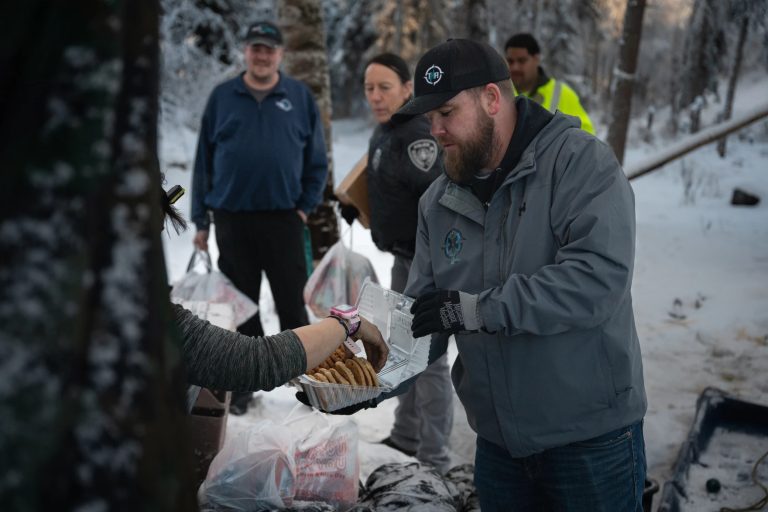by Antonia Gonzales and Sarah Gustavus
Los Angeles is a city, which covers more than 460 square miles and has nearly four million residents. Less than two percent of the population is Native American, according to U.S. Census statistics. It can often be difficult for Native people in Los Angeles County to find culturally relevant services, but people are turning to a Native center to help fill those needs.
On a summer evening in Los Angeles, men, women and children gather in a circle as a group of men sing and drum. They begin with a round dance and then transition into different styles of powwow dancing. Showing the steps to young people along the way. The social gathering is a service provided by United American Indian Involvement (UAII), which was started in the 1970s to help homeless Native people living on Skid Row.
Dance instructor Dave Patterson has been teaching powwow style dance for 12 years and said it is part of reliving his culture by teaching and participating in classes and social events.
“I go to work just like anybody else, I make a living, the hustle and bustle, especially in California it’s really fast,” Patterson said. “Sometimes I need that break to go back to my culture.”
Patterson is from the Sac and Fox, and Kickapoo tribes. He finds connecting with cultural activities provides balance in his busy life. He is among many urban Indians who are willing to travel long distances to get together with other Native people in LA County. Emcee of the class, Phillip Hale, Navajo, added that the class is about more than dancing.
“It helps our families here (in LA) who over the generations have lost their identity to gain back that identity and retain that knowledge to teach their kids and grandkids,” Hale said.
The disconnect from Native culture and identity is linked to federal government relocation policy of the 1950s. Native Americans were encouraged to leave reservations, get jobs in major cities, including LA, and assimilate.
Connie Fast Horse’s family was relocated from the Rosebud reservation in South Dakota to California. The Sicangu Lakota grandmother prepared food for the evening and said she brings children she knows to the cultural classes, which include traditional clothing instruction.
Fast Horse said young Native people living in the big city benefit from the people and services at United American Indian Involvement, “they have to learn it here and they begin to feel pride in their Native culture and it strengthens them spiritually.”
Combining cultural components such as beading, basket weaving, sage picking and family activities into Western programs is producing better outcomes for individuals and families, according to Dr. Carrie Johnson.
Johnson is the Director of Seven Generations Child and Family Services at United American Indian Involvement. Johnson is Wahpeton Dakota and is a licensed clinical psychologist. She added that isolation is often connected to child abuse and UAII used to see many reports around the holidays until the community requested more cultural teachings. About three years ago UAII started increasing cultural workshops after taking advice from its community advisory group.

Tso Yanez takes part in a drum and dance class at United American Indian Involvement in Los Angeles, California. The cultural activities have helped him with sobriety. (Photo-Antonia Gonzales)
“Once we started doing this, we haven’t had one child abuse report during the holidays,” Johnson said. “Most of them (clients) will have therapists or care coordinators who then talk to them about cultural activities and then they start coming to them.”
Back at the drum and dance class, Tso Yanez, Yaqui, Iroquois and Navajo, said Native culture helped guided him away from gangs and addiction.
“Even if you have that life you can remember where your culture and where your roots come from,” Yanez said.
The father of three brings his wife and kids to the classes and is a mentor to others struggling with addiction.
“If I wasn’t Native American and I was an addict I’d have a lot less fair of a chance because I grew up with ceremony, I grew up with teachings, I grew up with songs, I grew up with the dance,” Yanez said. “So, coming back to it gave it a reason to tie it all back together.”
Measuring success can often be challenging. That is why UAII is currently undergoing a five-year study of the drum, dance and regalia program. The research will produce data on whether it decreases mental health problems and substance abuse. The research project will also examine assessments of social connection and cultural identity.
This story is part of a joint project between National Native News is teaming up with New Mexico In Focus with help from the USC Annenberg-Center for Health Journalism and the Dennis A. Hunt Health Journalism Fund. You can view additional stories in the project about health and Native Americans here.



